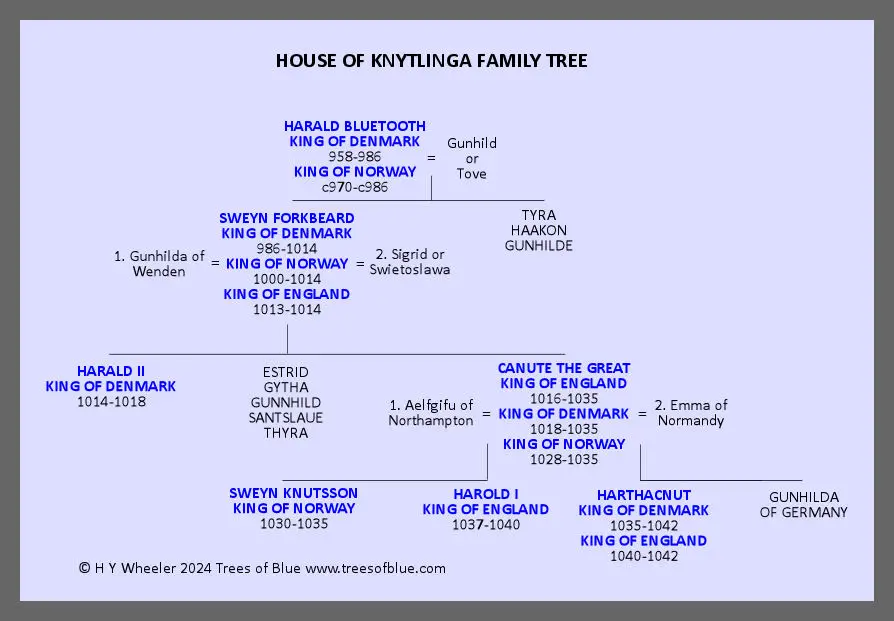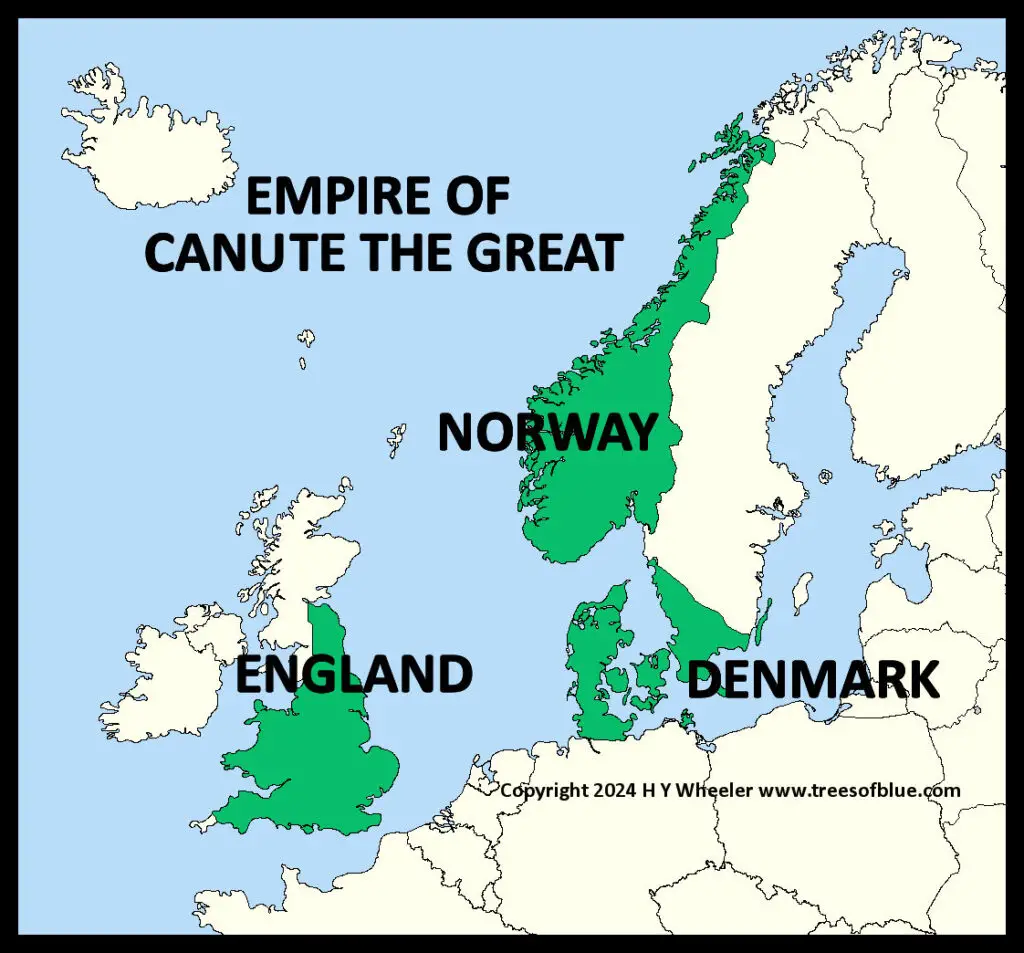The House of Knytlinga Family Tree shown below details all members of the Danish House of Knytlinga that ruled: England from 1013 – 1014 and 1016 – 1042; Denmark from 958 – 1042; and Norway from 970 – 986 and 1000 – 1035.
Kings are capitalized and coloured blue. Direct descendants of the House of Knytlinga are capitalized in black while spouses are shown in black and lower case.

What is the House of Knytlinga?
Knytlinga literally means the House of Canute’s descendants. It is also sometimes referred to as the House of Denmark, House of Gorm or the Jelling Dynasty.
Canute the Great earned his epithet ‘the Great’ for bringing peace to England after the turbulent reign of Aethelred the Unready. Although he was a Viking, Canute supported the Catholic church with donations and embarked on journeys to Rome which earned him the favour of the church. Although he brought peace to England he had to fight long and hard to become King of Denmark and Norway, a feat that was achieved by 1028.

History of the House of Kyntlinga
While the literal translation of the House of Kyntlinga is the House of Canute’s descendants, his father, grandfather and great-grandfather are also considered members of the House.
Gorm the Old, who is said to have been the son of the legendary Harthacnut I, succeeded as King of Denmark around 936. However, Gorm may only have ruled part of Denmark. His son, Harald Bluetooth succeeded Gorm in 958. Bluetooth was a great Viking warrior and conquered part of Norway.
Shortly before his death in 986, Harald had been ousted by his son Sweyn Forkbeard. Forkbeard continued his father’s practice of raiding the English coast. In 1002 Aethelred ordered the massacre of all Danes in England. Sweyn’s sister and her husband were among those murdered in the St Brice’s Day Massacre.
In retaliation Sweyn increased his raid on England exacting ever increasing ransoms from King Aethelred the Unready to cease his activities. In 1011 took the Archbishop of Canterbury hostage and when the King refused to pay ransom the Archbishop was killed. By late 1013 Sweyn had managed to conquer England and was proclaimed King. Aethelred and his family fled to Normandy.
Sweyn died in February 1014 and requested that his son, Canute succeed as King. However, the people of England were not willing to accept Canute and called for Aethelred to return. On his return Aethelred raised an army and marched against Canute, forcing him to flee to Denmark.
Canute’s brother Harald had been crowned King of Denmark and did not want to share the rule with Canute, so offered to provide him with an army with which to conquer England. Canute returned to England in 1015 and soon controlled northern England, known as Danelaw. Aethelred’s second reign was short-lived – he died in 1016 and was succeeded by his son Edmund Ironside.
By the summer of 1016 Canute and Edmund had reached a stalemate. They reached agreement that Canute would rule the Danelaw while Edmund would rule the south of England. Edmund Ironside died in November 1016 and Canute became King of England. The surviving children of Aethelred the Unready and Edmund Ironside fled abroad, as did many notable Anglo Saxon opponents of Canute. Those that remained were murdered on the orders of Canute.
Although he was already married to Aelfgifu of Northampton, Canute took Aethelred’s widow, Emma of Normandy, as his second wife in 1017.
Canute’s brother Harald, King of Denmark, died in 1018 and Canute claimed the crown of Denmark. However, his succession was not universally welcomed in Denmark and Canute was forced to quickly stamp out opposition. Canute designated his son by Emma of Normandy, Harthacnut, as heir to Denmark and placed him in the care of Jarl Ulf who ruled as Regent of Denmark in Canute’s absence.
In 1026, Denmark was facing attacks from Norway and Sweden. Canute sent English forces to support the Danes and they secured victory over the Norwegians and Swedes at the Battle of Helgea. Canute was declared King of Norway in 1028. In 1030 he sent his son by his first wife, Sweyn to rule Norway.
Canute died in 1035 and his son, Harthacnut, was his designated successor. However, Harthacnut was unable to leave Denmark at that time and his half-brother Harold Harefoot acted as regent. In 1037 Harthacnut had still not arrived in England to claim the crown, so Harold was crowned King in his stead.
King Harold I ruled for three years until his death in 1040. At this point Harthacnut was able to sail for England and be crowned King. During his two year reign, Harthacnut promised the English throne to King Magnus the Good of Norway, but when Harthacnut died in 1042, Magnus did not press the claim and the English crown returned to the House of Wessex as Harthacnut’s half brother, Edward the Confessor, the son of Emma of Normandy and Aethelred the Unready, took the throne.
Complete list of the Kings of the House of Knytlinga
Gorm the Old
King of Denmark – 936-958
Harald Bluetooth
King of Denmark – 958-986; King of Norway 970 -986
Sweyn Forkbeard
King of Denmark – 986-1014; King of Norway 1000-1014; King of England 1013-1014
Harald II
King of Denmark 1014-1018
Canute the Great
King of England 1016-1035, King of Denmark 1018-1035, King of Norway 1028-1035
Sweyn Knutsson
King of Norway 1030-1035
Harthacnut
King of Denmark 1035-1042, King of England 1040-1042
King Harold I
King of England 1037-1040
Published Aug 9 2024 – Updated – Dec 16 2024
Harvard Reference for House of Knytlinga Family Tree:
Heather Y Wheeler. (2024 – 2025). House of Knytlinga Family Tree 958 – 1042. Available: https://www.treesofblue.com/house-of-knytlinga-family-tree. Last accessed April 15th, 2025
